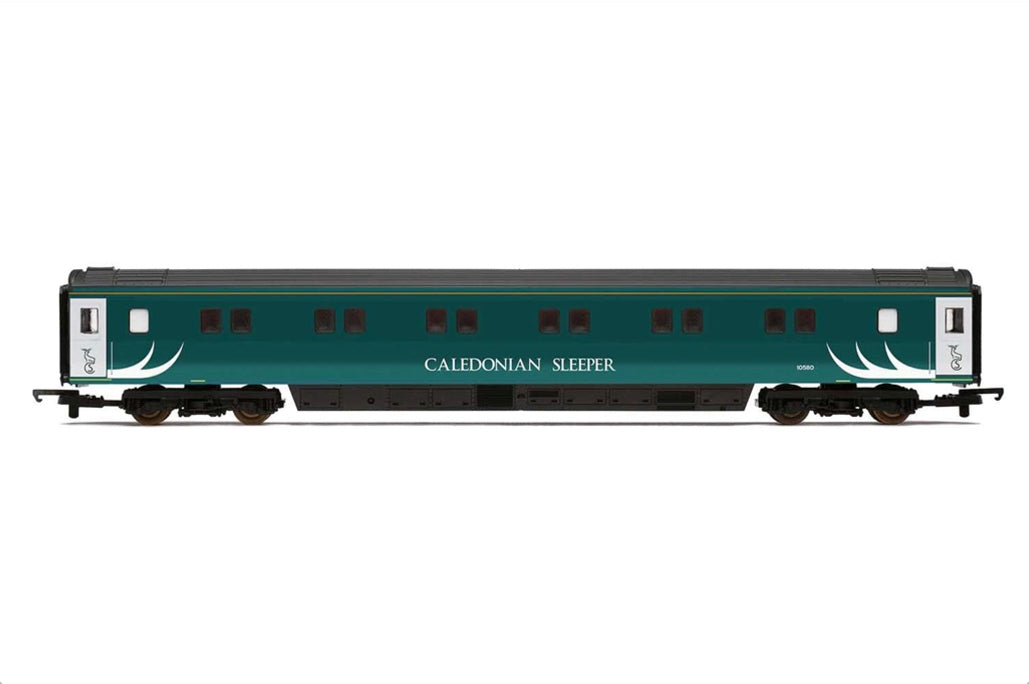You need to choose options for product.
-
 files/Screenshot2024-01-27at11.18.32.jpg
files/Screenshot2024-01-27at11.18.32.jpg
In-order to allow running at 125 mph on Britain's Victorian era railways, new rolling stock was needed by British Railways. Significant improvements over the Mk2 included new secondary air suspension between the bogies and the coach body as well as aerodynamic skirting on the underframe.
Mk3 coaches are 75ft (23m) long enabling far greater capacity than older coaches. Mk3 coaches also incorporate disk breaks and wheel slip protection enabling faster deceleration. The first Mk3 coaches to be delivered were used as part of the HST prototype along with the two Class 41 diesel power cars in 1972. Mk3 coaches entered service in 1975 along with the Class 43 forming the iconic InterCity 125 trainset. After the HST Mk3 coach variant was introduced, further Mk3 coaches were introduced to the West Coast Mainline (WCML) for use as part of locomotive hauled trains. Whilst Mk3 stock is standard for HST units, the standard locomotive hauled stock is Mk3a.
Mk3a stock differs from Mk3 stock due to the inclusion of buffers as well as a different electrical system that uses motor generator units in each coach to power air conditioning and other ancillaries Mk3a stock was built until 1984, before 3B stock with improved seating and lighting was built from 1985 to 1988. In 1979 British Rail ordered 236 Mk3a sleeper carriages to replace an ageing fleet of Mark 1 sleeper cars built to various designs and which dated from the late 1950s to early 1960s. This order was later reduced to 207 carriages. Mk3 sleeper vehicles remain in use on the Great Western Railway's Night Riviera from London Paddington to Penzance in Cornwall having had their interiors refurbished.
East coast sleeper services between London and Scotland ceased in May 1988, but the sleeper services on the WCML from Euston remined. Responsibility for operation of the remaining Anglo-Scottish services passed within British Rail from InterCity West Coast to ScotRail in March 1995. The Caledonian Sleeper franchise was initially handed out as part of the ScotRail franchise which was won by National Express who took over the services operation in 1997. National Express continued to use BR's Mk3 sleeper coaches, hiring locomotives from Virgin Trains until March 1998 and EWS from then on. Mk2 seated carriages were added to the service in 2000 featuring first class-style reclining seats, whilst the Mk3 sleeping cars were refurbished.
In 2004 the ScotRail Franchise including the Caledonian Sleeper was transferred to FirstGroup with the Caledonian sleeper rolling stock being repainted in FirstGroup's corporate blue, pink and white livery. In 2014 the Caledonian Sleeper became part of a separate franchise awarded to Serco who invested £100 million in new Mark 5 carriages which were introduced in April 2019, replacing the aging Mk3 stock.
In-order to allow running at 125 mph on Britain's Victorian era railways, new rolling stock was needed by British Railways. Significant improvements over the Mk2 included new secondary air suspension between the bogies and the coach body as well as aerodynamic skirting on the underframe.
Mk3 coaches are 75ft (23m) long enabling far greater capacity than older coaches. Mk3 coaches also incorporate disk breaks and wheel slip protection enabling faster deceleration. The first Mk3 coaches to be delivered were used as part of the HST prototype along with the two Class 41 diesel power cars in 1972. Mk3 coaches entered service in 1975 along with the Class 43 forming the iconic InterCity 125 trainset. After the HST Mk3 coach variant was introduced, further Mk3 coaches were introduced to the West Coast Mainline (WCML) for use as part of locomotive hauled trains. Whilst Mk3 stock is standard for HST units, the standard locomotive hauled stock is Mk3a.
Mk3a stock differs from Mk3 stock due to the inclusion of buffers as well as a different electrical system that uses motor generator units in each coach to power air conditioning and other ancillaries Mk3a stock was built until 1984, before 3B stock with improved seating and lighting was built from 1985 to 1988. In 1979 British Rail ordered 236 Mk3a sleeper carriages to replace an ageing fleet of Mark 1 sleeper cars built to various designs and which dated from the late 1950s to early 1960s. This order was later reduced to 207 carriages. Mk3 sleeper vehicles remain in use on the Great Western Railway's Night Riviera from London Paddington to Penzance in Cornwall having had their interiors refurbished.
East coast sleeper services between London and Scotland ceased in May 1988, but the sleeper services on the WCML from Euston remined. Responsibility for operation of the remaining Anglo-Scottish services passed within British Rail from InterCity West Coast to ScotRail in March 1995. The Caledonian Sleeper franchise was initially handed out as part of the ScotRail franchise which was won by National Express who took over the services operation in 1997. National Express continued to use BR's Mk3 sleeper coaches, hiring locomotives from Virgin Trains until March 1998 and EWS from then on. Mk2 seated carriages were added to the service in 2000 featuring first class-style reclining seats, whilst the Mk3 sleeping cars were refurbished.
In 2004 the ScotRail Franchise including the Caledonian Sleeper was transferred to FirstGroup with the Caledonian sleeper rolling stock being repainted in FirstGroup's corporate blue, pink and white livery. In 2014 the Caledonian Sleeper became part of a separate franchise awarded to Serco who invested £100 million in new Mark 5 carriages which were introduced in April 2019, replacing the aging Mk3 stock.
Flexible payment terms now available through Clearpay, Klarna and PayPal. Just select your desired payment method at the checkout stage.
Couldn't load pickup availability
Share


